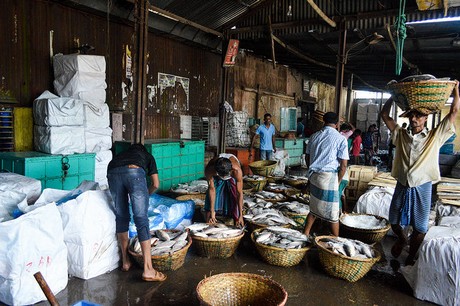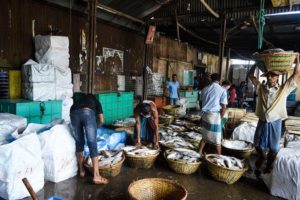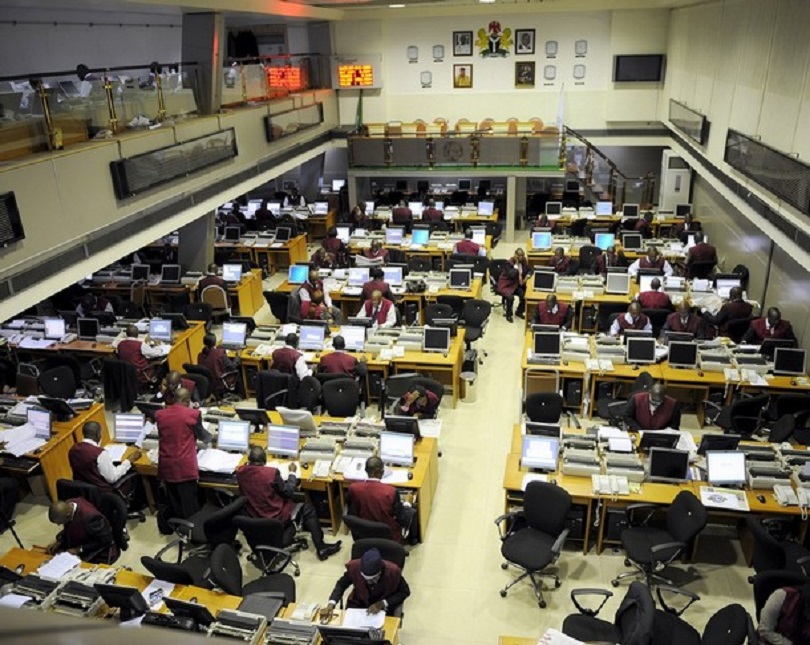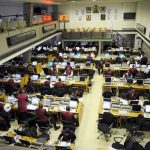Economy
ASEAN Fish Production to Hit 24% Global Output 2030


By Dipo Olowookere
A new report from WorldFish projects that fish production in ASEAN countries will reach 24% of global output by 2030. “Fish to 2050 in the ASEAN Region” says that policies to promote sustainable aquaculture expansion and law enforcement in fisheries management are critical to ensuring sustainable growth in both sectors.
For ASEAN countries, fish is a hugely important source of nutrition, also providing income, opening up employment opportunities and alleviating poverty. By volume, fish production is four times that of poultry and 20 times that of cattle in the ASEAN region.
Fish trade represents an important source of foreign currency earnings for many developing countries.
‘Fish to 2050 in the ASEAN Region’ produced in collaboration with the International Food Policy Research Institute (IFPRI) shows that aquaculture is expected to supply more than half of the fish for consumption in the region.
“The presence of strong institutional networks and private sector investment has played an important role in supporting the development of the aquaculture sector.
“However investment in research is essential to advance sustainable aquaculture technologies to improve efficiency gains, reduce production costs and mitigate environmental risks,” says Michael Phillips, Director of Aquaculture and Fisheries Science, WorldFish. “In addition to continuing to support the rise of sustainable aquaculture in ASEAN and the Asian region, WorldFish aims to scale this learning in Africa, a region where aquaculture remains a huge opportunity for income, employment and food and nutrition security.”
The report concludes that future efforts to enhance national data within ASEAN will provide better foresight for fish sector policy development.
The rise of Association of Southeast Asian Nations (ASEAN) countries’ fish production can be attributed to the rapid growth of aquaculture in Southeast Asia and its large offshore fishing fleet. Fisheries and aquaculture are increasingly becoming a primary source of animal protein, micronutrients, foreign exchange, livelihoods and wellbeing for the population in the region.
The majority of fish production occurs in developing countries in the South where competition for natural resources is high. Future fish supply and demand in ASEAN faces a number of challenges, especially climate change, which will cause disruptions in ocean and aquatic ecosystems. Other global challenges such as increasing demand for fishmeal and fish oil and the associated price increases of fish will also become key drivers of change in technologies and management.
Economy
Seplat Completes Conversion of Onshore Assets to PIA Fiscal Regime

By Adedapo Adesanya
Seplat Energy Plc has completed the conversion of its operated onshore oil and gas assets to the fiscal regime of Nigeria’s Petroleum Industry Act (PIA), marking a major regulatory milestone for the company.
In a statement issued on Tuesday, the dual-listed Nigerian energy firm said its subsidiaries, Seplat West Limited and Seplat East Onshore Limited, finalised the conversion from the former Petroleum Profits Tax framework to the PIA regime following the fulfilment of all technical and regulatory requirements.
The PIA, signed into law in August 2021, was introduced to modernise governance, improve transparency, attract investment, and make Nigeria’s petroleum fiscal framework more competitive globally.
The conversion covers assets previously held under Oil Mining Leases (OMLs) 4, 38, 41 and 53. During the first nine months of 2025, these assets recorded an average working interest production of 42,591 barrels of oil equivalent per day, accounting for approximately 31 per cent of Seplat’s total output.
According to the company listed on both the Nigerian Exchange Limited and the London Stock Exchange, the PIA framework is expected to support increased investment, production growth and improved operational efficiency. The anticipated impact of the conversion had already been factored into Seplat’s medium-term guidance presented at its Capital Markets Day in September 2025.
Seplat noted that it executed Conversion Contracts with its joint venture partners in February 2023 and has since worked closely with the Nigerian Upstream Petroleum Regulatory Commission (NUPRC) to complete the process. New Petroleum Mining Lease (PML) and Petroleum Prospecting Licence (PPL) numbers have now been issued, with PIA-based operations expected to commence from January 1, 2026, subject to regulatory guidance.
Commenting on the development, Chief Executive Officer Roger Brown said the successful conversion reflects the company’s commitment to regulatory compliance and value creation.
“Conversion to the PIA fiscal regime has been an important focus for Seplat, and we are delighted to have delivered, alongside our respective joint venture partners, the conversion of our onshore operated assets within the timeline outlined at our recent Capital Markets Day,” Mr Brown said.
He added that the transition positions the company for improved profitability and stronger cash flow margins in its onshore business.
Seplat also disclosed that it is continuing efforts to convert its offshore assets to the PIA regime, with a target completion date of 2027.
Economy
NASD Index Rises 0.16% on Renewed Investors’ Appetite

By Adedapo Adesanya
The NASD Over-the-Counter (OTC) Securities Exchange rose by 0.16 per cent on Monday, December 22 as investors showed hunger for unlisted stocks.
Trading data showed that the volume of securities traded at the session surged by 532.9 per cent to 12.6 million units from the previous 1.9 million units, as the value of transactions jumped by 64.3 per cent to N713.6 million from N80.3 million, though the number of deals moderated by 13.5 per cent to 32 deals from the 37 deals recorded in the previous trading session.
Infrastructure Credit Guarantee Company (InfraCredit) Plc ended the day as the most traded stock by value on a year-to-date basis with 5.8 billion units sold for N16.4 billion, followed by Okitipupa Plc with 178.9 million units worth N9.5 billion, and MRS Oil Plc with 36.1 million units transacted for N4.9 billion.
InfraCredit Plc also finished the trading day as the most traded stock by volume on a year-to-date basis with 5.8 billion units traded for N16.4 billion, trailed by Industrial and General Insurance (IGI) Plc with the sale of 1.2 billion units for N420.7 million, and Impresit Bakolori Plc with a turnover of 537.0 million units valued at N524.9 million.
The unlisted securities market printed a price loser, FrieslandCampina Wamco Nigeria Plc, which dropped 20 Kobo to sell at N53.80 per share versus last Friday’s closing price of N54.00 per share.
However, the loss was offset by the trio of NASD Plc, Golden Capital Plc, and UBN Property Plc.
NASD Plc gained N5.00 to close at N60.00 per unit versus N55.00 per unit, Golden Capital Plc appreciated by 77 Kobo to N8.45 per share from N7.68 per share, and UBN Property Plc improved by 22 Kobo to N2.43 per unit from N2.21 per unit.
As a result, the market capitalisation increased by N3.38 billion to N2.125 billion from N2.121 trillion, and the NASD Unlisted Security Index (NSI) grew by 5.65 per cent to 3,552.06 points from 3,546.41 points.
Economy
Nigeria’s Stock Exchange Sustains Bull Run by 0.26%

By Dipo Olowookere
The bulls remained on the floor of the Nigerian Exchange (NGX) Limited on Monday, rallying by 0.26 per cent at the close of transactions.
This was buoyed by the gains recorded by 34 equities on Nigeria’s stock exchange, which outweighed the losses posted by 20 equities, indicating a positive market breadth index and strong investor sentiment.
Aluminium Extrusion gained 9.72 per cent to quote at N13.55, International Energy Insurance improved by 9.69 per cent to N2.49, Mecure Industries rose by 9.64 per cent to N60.30, Royal Exchange expanded by 9.60 per cent to N1.94, and Austin Laz grew by 9.50 per cent to N2.65.
On the flip side, Custodian Investment depleted by 10.00 per cent to N35.10, ABC Transport crashed by 10.00 per cent to N3.15, Prestige Assurance weakened by 7.41 per cent to N1.50, and Guinea Insurance slipped by 7.38 per cent to N1.13.
During the session, investors traded 451.5 million shares worth N13.0 billion in 33,327 deals compared with the 1.5 billion shares valued at N21.8 billion transacted in 25,667 deals in the preceding session, showing spike in the number of deals by 29.84 per cent, and a decline in the trading volume and value by 69.90 per cent and 40.37 per cent apiece.
The first trading session of the Christmas week had Tantalizers as the most active with 50.2 million units sold for N127.5 million, First Holdco transacted 32.6 million units worth N1.5 billion, Access Holdings exchanged 27.3 million units valued at N562.3 million, Custodian Investment traded 22.1 million units for N857.8 million, and Chams transacted 21.3 million units valued at N71.1 million.
When the closing gong was struck at 2:30 pm to end trading activities, the All-Share Index (ASI) was up by 401.69 points to 152,459.07 points from 152,057.38 points and the market capitalisation went up by N256 billion to N97.193 trillion from N96.937 trillion.
-

 Feature/OPED6 years ago
Feature/OPED6 years agoDavos was Different this year
-
Travel/Tourism9 years ago
Lagos Seals Western Lodge Hotel In Ikorodu
-

 Showbiz3 years ago
Showbiz3 years agoEstranged Lover Releases Videos of Empress Njamah Bathing
-

 Banking7 years ago
Banking7 years agoSort Codes of GTBank Branches in Nigeria
-

 Economy3 years ago
Economy3 years agoSubsidy Removal: CNG at N130 Per Litre Cheaper Than Petrol—IPMAN
-

 Banking3 years ago
Banking3 years agoFirst Bank Announces Planned Downtime
-

 Banking3 years ago
Banking3 years agoSort Codes of UBA Branches in Nigeria
-

 Sports3 years ago
Sports3 years agoHighest Paid Nigerian Footballer – How Much Do Nigerian Footballers Earn













